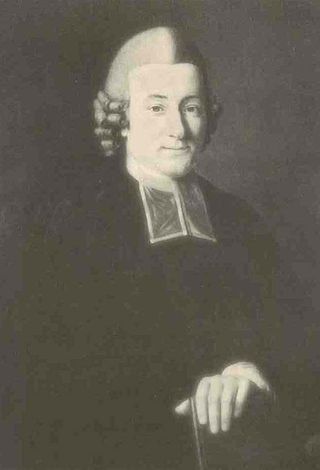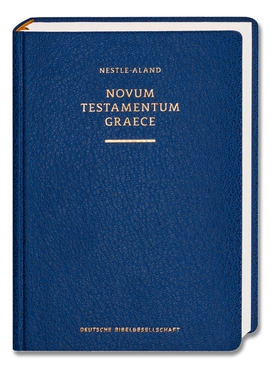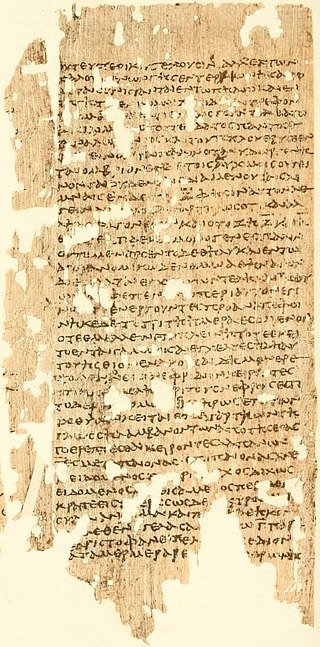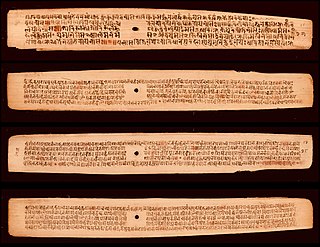Recension is the practice of editing or revising a text based on critical analysis. [1] When referring to manuscripts, this may be a revision by another author. The term is derived from Latin recensio ("review, analysis").
In textual criticism (as is the case with Biblical scholarship) the count noun recension is a family of manuscripts sharing similar traits; [2] for example, the Alexandrian text-type may be referred to as the "Alexandrian recension". The term recension may also refer to the process of collecting and analyzing source texts in order to establish a tree structure leading backward to a hypothetical original text.

The Septuagint, is the earliest extant Greek translation of the Hebrew Bible from the original Hebrew. The full title derives from the story recorded in the Letter of Aristeas to Philocrates that "the laws of the Jews" were translated into the Greek language at the request of Ptolemy II Philadelphus by seventy-two Jewish translators—six from each of the Twelve Tribes of Israel.

Textual criticism is a branch of textual scholarship, philology, and of literary criticism that is concerned with the identification of textual variants, or different versions, of either manuscripts or of printed books. Such texts may range in dates from the earliest writing in cuneiform, impressed on clay, for example, to multiple unpublished versions of a 21st-century author's work. Historically, scribes who were paid to copy documents may have been literate, but many were simply copyists, mimicking the shapes of letters without necessarily understanding what they meant. This means that unintentional alterations were common when copying manuscripts by hand. Intentional alterations may have been made as well, for example, the censoring of printed work for political, religious or cultural reasons.
In textual criticism of the New Testament, the Alexandrian text-type is one of the main text types. It is the text type favored by the majority of modern textual critics and it is the basis for most modern Bible translations.

Johann Jakob Griesbach was a German biblical textual critic. Griesbach's fame rests upon his work in New Testament criticism, in which he inaugurated a new epoch. His solution to the synoptic problem bears his name, but the Griesbach hypothesis has become, in modern times, known as the Two-Gospel hypothesis.

Textus Receptus refers to all printed editions of the Greek New Testament from Erasmus's Novum Instrumentum omne (1516) to the 1633 Elzevir edition. It was the most commonly used text type for Protestant denominations.

The Bible has been translated into many languages from the biblical languages of Hebrew, Aramaic, and Greek. As of 2022 all of the Bible has been translated into 724 languages, the New Testament has been translated into an additional 1,617 languages, and smaller portions of the Bible have been translated into 1,248 other languages according to Wycliffe Global Alliance. Thus, at least some portions of the Bible have been translated into 3,589 languages.

The Codex Alexandrinus, designated by the siglum A or 02, δ 4, is a manuscript of the Greek Bible, written on parchment. Using the study of comparative writing styles (palaeography), it has been dated to the fifth century. It contains the majority of the Greek Old Testament and the Greek New Testament. It is one of the four Great uncial codices. Along with Codex Sinaiticus and Vaticanus, it is one of the earliest and most complete manuscripts of the Bible.

Novum Testamentum Graece is a critical edition of the New Testament in its original Koine Greek, forming the basis of most modern Bible translations and biblical criticism. It is also known as the Nestle–Aland edition after its most influential editors, Eberhard Nestle and Kurt Aland. The text, edited by the Institute for New Testament Textual Research, is currently in its 28th edition, abbreviated NA28.

Homeric scholarship is the study of any Homeric topic, especially the two large surviving epics, the Iliad and Odyssey. It is currently part of the academic discipline of classical studies. The subject is one of the oldest in scholarship. For the purpose of the present article, Homeric scholarship is divided into three main phases: antiquity; the 18th and 19th centuries; and the 20th century and later.

New Testament manuscripts in Greek are categorized into five groups, according to a scheme introduced in 1981 by Kurt and Barbara Aland in The Text of the New Testament. The categories are based on how each manuscript relates to the various text-types. Generally speaking, earlier Alexandrian manuscripts are category I, while later Byzantine manuscripts are category V. Aland's method involved considering 1000 passages where the Byzantine text differs from non-Byzantine text. The Alands did not select their 1000 readings from all of the NT books; for example, none were drawn from Matthew and Luke.

A biblical manuscript is any handwritten copy of a portion of the text of the Bible. Biblical manuscripts vary in size from tiny scrolls containing individual verses of the Jewish scriptures to huge polyglot codices containing both the Hebrew Bible (Tanakh) and the New Testament, as well as extracanonical works.

Papyrus 45, designated by siglum 𝔓45, is an early Greek New Testament manuscript written on papyrus, and is one of the manuscripts comprising the Chester Beatty Papyri, a group of early Christian manuscripts discovered in the 1930s, and purchased by business man and philanthropist, Alfred Chester Beatty. Beatty purchased the manuscript in the 1930s from an Egyptian book dealer, and it was subsequently published in The Chester Beatty Biblical Papyri, Descriptions and Texts of Twelve Manuscripts on Papyrus of the Greek Bible by palaeographer, biblical and classical scholar Frederic G. Kenyon in 1933. Manuscripts among the Chester Beatty Papyri have had several places of discovery associated with them, the most likely being the Faiyum in Egypt. Using the study of comparative writing styles (palaeography), it has been dated to the early 3rd century CE. This therefore makes it the earliest example of not only the four Gospels contained in one volume, but also the Acts of the Apostles. It contains verses in fragmentary form from the texts of Matthew chapters 20-21 and 25-26; Mark chapters 4-9 and 11-12; Luke chapters 6-7 and 9-14; John chapters 4-5 and 10-11; and Acts chapters 4-17. The manuscript is currently housed at the Chester Beatty Library, Dublin, Ireland, except for one leaf containing Matt. 25:41-26:39 which is at the Papyrus Collection of the Austrian National Library in Vienna.

Papyrus 75, designated by the siglum 𝔓75, is an early Greek New Testament manuscript written on papyrus. It contains text from the Gospel of Luke 3:18-24:53, and John 1:1-15:8. It is generally described as "the most significant" papyrus of the New Testament to be discovered so far. Using the study of comparative writing styles (palaeography), it has been traditionally dated to the third century. It is due to this early dating that the manuscript has a high evaluation, and the fact its text so closely resembles that of the fourth-century Codex Vaticanus.

Uncial 030, designated by siglum U or 030, ε 90, is a Greek uncial manuscript of the New Testament on parchment, dated palaeographically to the 9th century. The manuscript has complex contents, with full marginalia.

Papyrus 35, designated by 𝔓35, is an early copy of the New Testament in Greek. It is a papyrus manuscript of the Gospel of Matthew, it contains only Matthew 25:12-15.20-23. The manuscript paleographically has been assigned to the 3rd or 4th century.

Papyrus 39, signed by 𝔓39, is an early copy of the New Testament in Greek. It is a papyrus manuscript of the Gospel of John, it contains only John 8:14-22. The manuscript paleographically had been assigned to the 3rd century. Written by professional scribe, in 25 lines per page, in large, beautiful letters. It has numbered pages.

Papyrus 47, designated by siglum 𝔓47, is an early Greek New Testament manuscript written on papyrus, and is one of the manuscripts comprising the Chester Beatty Papyri. Manuscripts among the Chester Beatty Papyri have had several places of discovery associated with them, the most likely being the Faiyum. Using the study of comparative writing styles (palaeography), it has been dated to the early 3rd century CE. The codex contains text from the Book of Revelation chapters 9 through 17. It is currently housed at the Chester Beatty Library in Dublin.

Nāradasmṛti is a part of the Dharmaśāstras, written about 2400 years ago in two recensions the south India Naradamanusamhita and Nepal, in Newari language that serves as a collection of legal maxims relating to the topic of dharma. This text is purely juridical in character in that it focuses solely on procedural and substantive law. Known as the "juridical text par excellence," the Nāradasmṛti is the only Dharmaśāstra text to not cover areas such as righteous conduct and penance. Its focused nature has made the text highly valued by rulers and their governments, in Indian subcontinent and southeast Asia, likely as an aid of carrying out their dharma of justly ruling the country.

Minuscule 579, ε 376, is a Greek minuscule manuscript of the New Testament Gospels, written on parchment. Using the study of comparative writing styles (palaeography), it has been dated to the 13th century. It was formerly labelled as 80e. The manuscript has some missing portions of text.

Textual criticism of the New Testament is the identification of textual variants, or different versions of the New Testament, whose goals include identification of transcription errors, analysis of versions, and attempts to reconstruct the original text. Its main focus is studying the textual variants in the New Testament.